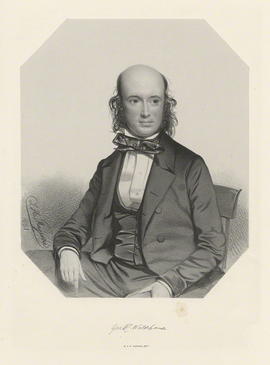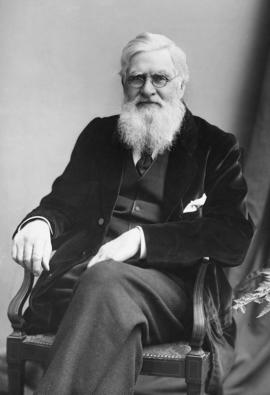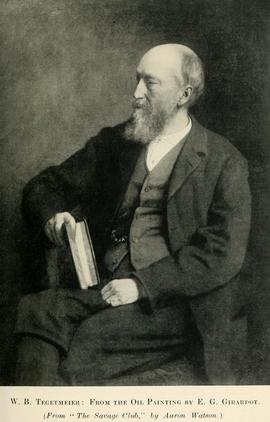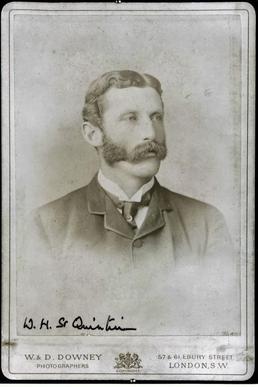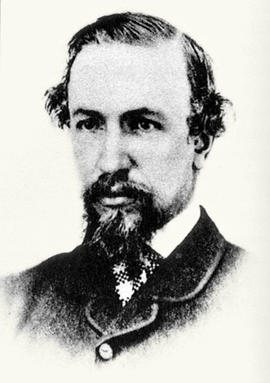George Robert Waterhouse was an English naturalist. He became interested in entomology though his father (an amateur entomologist) and he founded the Entomological Society of London along with Frederick William Hope in 1833 with himself as honorary curator. He became its president in 1849-50. The Royal Institution at Liverpool appointed him curator of its museum in 1835 and he exchanged this in 1836 for a position at the Zoological Society of London. His early work was on cataloguing the mammals at the museum and although he completed the work the next year, it was not published as he had not followed the quinary system of that time. He was invited to join Charles Darwin on the voyage of the Beagle but he declined it. On Darwin's return, the collection of mammals and beetles was entrusted to him. In November 1843 he became an assistant in the mineralogical department of the British Museum of Natural History. He became keeper in 1851 and held the position until his retirement in 1880. He was the author of A Natural History of the Mammalia (1846-48). He assisted Louis Agassiz with his Nomenclator Zoologicus.
Alfred Russel Wallace was a British naturalist, explorer, geographer, anthropologist, biologist and illustrator. He is best known for independently conceiving the theory of evolution through natural selection; his paper on the subject was jointly published with some of Charles Darwin's writings in 1858. This prompted Darwin the publish On the Origin of Species.
Jules Pierre Verreaux was a French botanist and ornithologist, and a professional collector and trader in natural history specimens. Verreaux worked for the family business, Maison Verreaux, established in 1803 by his father, Jacques Philippe Verreaux, which was the earliest known company that dealt in objects of natural history. The company funded collection expeditions to various parts of the world
Count Hercules Turati or Ercole Turati was a wealthy Milanese banker and naturalist. He purchased natural history specimens and built up a very large private collection of more than 20,000 bird specimens, mostly mounted, which include the now extinct Great Auk. The Museo Civico di Storia Naturale di Milano was constructed to house the specimens that his heirs donated to the city after his death
Henry Baker Tristram was an English clergyman, Bible scholar, traveller and ornithologist. As a parson-naturalist he was an early supporter of Darwinism, attempting to reconcile evolution and creation. In 1858 he read the simultaneously-published papers by Charles Darwin and Alfred Russell Wallace that were read in the Linnean Society, and published a paper in Ibis. He attempted to reconcile this early acceptance of evolution with creation. Following the Oxford debate between Thomas Henry Huxley and Samuel Wilberforce, Tristram, after early acceptance of the theory, rejected Darwinism. Tristram was a founded and original member of the British Ornithologists' Union, and appointed a fellow of the Royal Society in 1868. Edward Bartlett, an English ornithologist and son of Abraham Dee Bartlett, accompanied Tristram to Palestine in 1863-1864. During his travels he accumulated an extensive collection of bird skins, which he sold to the World Museum Liverpool
William Bernhardt Tegetmeier was an English naturalist, a founding member of the Savage Club, a popular writer and journalist of domestic science. A correspondent and friend of Charles Darwin, Tegetmeier studied pigeon breeds and the optimality of hexagonal honeycomb cells constructed by honeybees. He wrote a number of books dealing with home economics, poultry farming, pigeon breeds, bee-keeping and on the maintenance of livestock
Edward Smith-Stanley, 13th Earl of Derby was a politician, peer, landowner, builder, farmer, art collector and naturalist. He was the patron of the writer Edward Lear.
In 1834 he succeeded his father as 13th Earl of Derby and withdrew from politics, instead concentrating on his natural history collection at Knowsley Hall, near Liverpool. He had a large collection of living animals; at his death there were 1,272 birds and 345 mammals at Knowsley, shipped to England by explorers such as Joseph Burke. From 1828 to 1833 he was President of the Linnean Society. Several species were named after him. He was President of the Zoological Society 1831-1851.
William Herbert St Quintin was a British naturalist. He was a keen ornithologist, keeping a private collection of birds including Great bustards, a secretary bird and a tui. He was a founding member of the Avicultural Society in 1895, president of the Yorkshire Naturalists' Union in 1909, a member of the British Ornithologists' Union from 1883 to 1922 and also served on the council of the Royal Society for the Protection of Birds from 1908-1919
George Brettingham Sowerby II was a British naturalist, illustrator and conchologist. Together with his father, George Brettingham Sowerby I, he published the Thesaurus Conchyliorum and other illustrated works on molluscs. He was elected a Fellow of the Linnean Society on 7th May 1844. He was the father of George Brettingham Sowerby III, also a malacologist
Osbert Salvin was an English naturalist, ornithologist and herpetologist, best known for co-authoring Biologia Centrali-Americana (1879-1915) with Frederick DuCane Godman. In 1871 Salvin became editor of The Ibis. He was appointed to the Strickland Curatorship in the University of Cambridge, and produced his Catalogue of the Strickland Collection. He was one of the original members of the British Ornithologists' Union. He produced the volumes on the Trochilidae and Procellariidae in the Catalogue of Birds in the British Museum. One of his last works was the completion of Lord Lilford's Coloured Figures of British Birds (1897). Salvin was a Fellow of the Royal Society, the Linnean, Entomogical and Zoological Society of London. At the time of his death he was Secretary of the British Ornithologists' Union.
